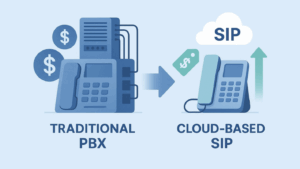
Business Texting: Integrating SMS with SIP Services
Business Texting: Integrating SMS with SIP Services
Business texting is becoming essential. With more people using texts for communication, it’s crucial to integrate SMS with your existing SIP (Session Initiation Protocol) services. This integration is important because it streamlines communication and improves efficiency. By merging SMS with your SIP system, you can manage texts and calls in one place, saving time and reducing costs.

This process will help your business streamline operations, improve customer interactions, and increase internal communication efficiency. Here’s a quick rundown to help you get started:
- Improved Customer Engagement:
- Faster response times with instant messaging.
- Streamlined Internal Communications:
- Improve coordination with text-based updates.
- Cost-Effective Solutions:
- Lower costs through internet protocol messaging.
- Unified Communication Platform:
- Combine voice, text, and multimedia messaging in one platform.
- Enhanced Data Collection and Analytics
- Get insights into call analytics to continually improve.
Keep reading to learn how to integrate SMS with SIP services efficiently and effectively.
The Benefits of Integrating SMS with SIP Services
Integrating SMS with SIP services offers numerous benefits for businesses looking to modernize and improve their communication strategies. Here are some of the key advantages:
Improved Customer Engagement and Response Times
Integrating SMS with SIP services allows businesses to engage with customers in real-time. Text messages are typically read within minutes, offering a faster response time compared to emails or phone calls.
Example: A customer service team can quickly address inquiries and resolve issues through SMS, leading to higher customer satisfaction rates. According to TechRadar, businesses can reduce call costs significantly by using SIP-based telephony, making it a cost-effective option for customer engagement.
Streamlined Internal Communications
SMS integration with SIP services simplifies internal communication, making it easier for teams to coordinate and collaborate.
Example: An internal team can use SMS to send quick updates, reminders, or alerts, ensuring everyone stays informed and aligned. This is especially useful for remote teams or employees who are frequently on the move.
Cost-Effective Alternative to Traditional Phone Calls
Using internet protocols for messaging can lower costs compared to traditional phone calls. Businesses can save money on long-distance and international communication by leveraging SIP services.
Example: A company can use SIP trunking to manage both voice and text communication over the internet, reducing the need for expensive phone lines. As noted by SIP.US, this makes it easier to manage and scale communication systems without incurring high costs.
Improved Data Collection and Analytics Capabilities
Integrating SMS with SIP services provides better data collection and analytics capabilities. Businesses can track message delivery, response times, and customer interactions to gain valuable insights.
Example: A marketing team can analyze SMS campaign performance, such as open rates and click-through rates, to optimize future campaigns. This data-driven approach helps in making informed decisions and improving overall communication strategies.

Improved Data Collection and Analytics
Integrating SMS with SIP services not only streamlines communication but also improves data collection and analytics. By analyzing data from SMS campaigns, businesses can gain valuable insights into customer behavior and preferences.
Example: A marketing team can track metrics such as delivery rates, response times, and conversion rates from an SMS campaign. This helps them understand what works best and refine future strategies for better results. This data-driven approach leads to more effective communication and improved customer engagement.
By integrating SMS with SIP services, businesses can enjoy improved customer engagement, streamlined internal communications, cost-effective solutions, and improved data collection and analytics capabilities. These benefits make it an essential strategy for any modern enterprise looking to stay competitive and efficient.
Keep reading to learn about best practices for implementing business texting.
Best Practices for Implementing Business Texting
Implementing business texting effectively requires a well-thought-out strategy and best practices. Here’s how to get started:
Clear Texting Strategy and Policy Development
First, develop a clear strategy and policy for business texting. This ensures consistency and compliance across the organization.
- Define Objectives: Identify what you aim to achieve with business texting. Is it for customer support, marketing, or internal communication?
- Set Guidelines: Establish rules for when and how to use text messaging. This includes message tone, frequency, and content type.
- Documentation: Create a policy document that outlines these guidelines and make it accessible to all employees.
Employee Training on Appropriate Use and Etiquette
Training employees is crucial for the successful implementation of business texting.
- Training Programs: Conduct training sessions to teach employees about the new texting policies and best practices.
- Etiquette: Emphasize the importance of professionalism in text messages. This includes using proper language, being concise, and avoiding slang.
- Role-Playing: Use role-playing exercises to help employees practice real-life scenarios they might encounter.
Ensuring Compliance with Regulations (TCPA)
Compliance with regulations like the Telephone Consumer Protection Act (TCPA) is essential to avoid legal issues.
- Understand TCPA: Familiarize yourself with TCPA requirements, such as obtaining consent before sending promotional texts.
- Opt-In Mechanisms: Implement clear opt-in mechanisms for customers to subscribe to text messages.
- Record Keeping: Maintain records of customer consents and any opt-out requests to ensure compliance.
Leveraging Automation and AI for Efficient Message Handling
Automation and AI can significantly improve the efficiency of your business texting.
- Automated Responses: Use automated responses for common inquiries to save time and provide instant replies.
- AI Chatbots: Implement AI chatbots to handle initial customer interactions and route complex queries to human agents.
- Segmentation: Use automation tools to segment your audience based on their preferences and behaviors for targeted messaging.
By following these best practices, businesses can ensure a smooth and effective implementation of business texting. This not only improves communication but also improves customer satisfaction and operational efficiency.
Ready to see real-world examples and success stories? Keep reading to learn more.
Real-World Applications and Success Stories
Business texting can transform various aspects of your operations. Here are some real-world applications and success stories:
Customer Service and Support Use Cases
Text messaging is a game-changer for customer service. It allows for quick, convenient communication that meets customers where they are.
- Quick Resolutions: Companies have found that texting can resolve customer issues faster than traditional phone calls or emails. Customers appreciate the speed and convenience.
- Proactive Support: Businesses use SMS to send helpful reminders, updates, and troubleshooting tips. This proactive approach reduces the number of incoming support queries.
Sales and Marketing Applications
Text messaging isn’t just for support—it’s a powerful tool for sales and marketing too.
- Promotional Campaigns: Businesses can send targeted promotions and special offers via SMS, boosting engagement and sales. For instance, a retail company might send a discount code to customers who haven’t shopped in a while.
- Lead Nurturing: Sales teams use SMS to follow up with leads, schedule calls, and send product information. This keeps prospects engaged and moves them through the sales funnel faster.
Appointment Reminders and Scheduling
Missed appointments can be costly. Text messaging helps minimize no-shows and keeps schedules on track.
- Automated Reminders: Many businesses use automated SMS reminders to confirm appointments. For example, a healthcare provider might send a reminder the day before a patient’s visit.
- Easy Rescheduling: If someone needs to reschedule, they can simply reply to the text. This quick interaction reduces the administrative burden on your staff.
Internal Team Communication and Collaboration
Text messaging isn’t just for external communication—it can streamline internal operations too.
- Instant Updates: Teams can use SMS for urgent updates or changes. For example, a manager might text team members about a meeting time change.
- Collaboration: Texting facilitates quick collaboration, especially for remote teams. Employees can share updates, ask questions, and coordinate tasks in real-time.
By integrating SMS with SIP services, businesses can improve customer satisfaction, boost sales, reduce no-shows, and improve internal communication.
Overcoming Challenges in SMS-SIP Integration
Integrating SMS with SIP services can boost your business communication, but it’s not without challenges. Let’s break down how to tackle them effectively.
Security Concerns and Privacy Issues
Security is a top priority when integrating SMS with SIP services. Like any internet-based service, SIP trunking can be vulnerable to cyber threats.
Best Practices:
- Implement Robust Security Measures: Use firewalls and intrusion detection systems. Regular updates and patches are crucial to keep your system secure.
- Choose a Secure SIP Provider: Opt for a provider that prioritizes security. Look for features like encryption and regular security audits. SIP.US offers comprehensive security measures to protect your data.
- User Training: Educate your employees about phishing attacks and secure communication practices.
Managing Message Volume and Response Times
Handling a high volume of messages can be daunting. Slow response times can frustrate customers and reduce the effectiveness of your communication strategy.
Best Practices:
- Leverage Automation: Use automated responses for common queries. This can help manage the initial influx of messages and ensure timely replies.
- Monitor and Optimize: Regularly review your message handling process. Identify bottlenecks and optimize your workflow to improve response times.
- Scalability: Ensure your SIP service can scale with your business needs. ClearlyIP’s SIP trunks are known for their scalability, accommodating growing messaging needs seamlessly.
CRM Integration and Business Systems
Integrating SMS with your existing CRM and business systems can streamline operations but requires careful planning.
Best Practices:
- API Integration: Use APIs to connect your SMS services with your CRM. This allows for seamless data flow and better customer insights. Here’s a useful guide on API integration.
- Unified Communication Platform: Consider using a platform that consolidates voice, text, and multimedia messaging. This reduces complexity and improves efficiency.
- Regular Updates: Keep your systems updated to ensure compatibility and smooth operation.
By addressing these challenges head-on, you can make the most of integrating SMS with SIP services. This not only improves your communication strategy but also ensures a secure and efficient operation.
The Future of Business Texting and SIP Integration
The landscape of business communication is evolving rapidly. Integrating SMS with SIP services is part of this change. Let’s explore the emerging trends and technologies shaping the future.
Emerging Trends and Technologies
AI Integration
AI is revolutionizing business communication. By 2026, AI could power 1 in 10 customer interactions. This includes intelligent chatbots that handle customer queries and predictive analytics for better decision-making. Learn more about AI in business communication.
5G Networks
As 5G becomes more widespread, expect higher call quality and more reliable connections. This is especially beneficial for mobile users, ensuring seamless communication on the go. Discover the impact of 5G on business.
Improved Video Capabilities
With remote work on the rise, video conferencing is becoming essential. Future VoIP solutions may include advanced video features like virtual and augmented reality, enhancing the remote collaboration experience. Explore the future of video conferencing.
IoT Integration
The Internet of Things (IoT) is expanding. VoIP solutions might integrate with smart devices, enabling new forms of communication and automation. Imagine your CRM system automatically sending a text when a sensor detects an issue. Read about IoT and business communication.
Preparing for the Evolving Communication Landscape
Stay Updated on Trends
Keep an eye on the latest trends and technologies in business communication. Subscribe to industry newsletters and follow thought leaders to stay informed. Check out this industry newsletter.
Invest in Scalable Solutions
Choose communication solutions that can grow with your business. Scalable SIP services ensure you can handle increasing message volumes and new technology integrations smoothly. Learn about scalable SIP solutions.
Train Your Team
Ensure your team is well-trained on new tools and technologies. Regular training sessions can help them adapt quickly to changes and make the most of new features.
Prioritize Security
As communication technologies evolve, so do cyber threats. Continuously update your security measures and educate your team on best practices to protect your data. Stay updated on cybersecurity.
Leverage Data and Analytics
Use data analytics to gain insights into your communication strategies. This can help you identify areas for improvement and make data-driven decisions to improve customer engagement.
By staying ahead of these trends and preparing your business for the future, you can ensure seamless and effective communication.
Ready to dive deeper into business texting? Check out our FAQ section for more insights.
Frequently Asked Questions about Business Texting: Integrating SMS with SIP Services
Can SIP send SMS?
Yes, SIP (Session Initiation Protocol) can send SMS. VoIP numbers, which are part of SIP services, support SMS messaging. This allows businesses to send and receive text messages using their existing phone numbers. Integrating SMS with SIP services can streamline communication and improve customer engagement.
For example, a business can send appointment reminders, order confirmations, or promotional messages directly from their VoIP system. This not only saves time but also ensures that all communication channels are unified.
How do I automate text messages for my business?
Automating text messages can greatly improve efficiency and ensure timely communication. Here’s how you can do it:
- Choose an Automated Texting Service: Select a reliable service that supports bulk messaging and automation. Look for features like scheduling, personalization, and integration capabilities.
- Upload Contacts: Import your contact list into the texting platform. Ensure your contacts are segmented into groups based on criteria such as customer behavior, demographics, or purchase history.
- Create Message Templates: Develop templates for common messages like appointment reminders, order updates, and promotional offers. Personalize these templates with placeholders for names, dates, and other variables.
- Set Up Automation Rules: Define triggers for your messages. For example, you can schedule reminders to be sent 24 hours before an appointment or send a thank-you message after a purchase.
- Monitor and Adjust: Use analytics to track the performance of your automated messages. Adjust your strategy based on open rates, response rates, and customer feedback.
By automating your text messages, you can ensure consistent and timely communication with your customers, enhancing their experience and loyalty.
What is the difference between SMS and MMS?
SMS (Short Message Service) and MMS (Multimedia Message Service) are both text messaging services, but they have key differences:
- SMS: This is the most common form of text messaging, limited to 160 alphanumeric characters. It’s ideal for simple, text-only messages like reminders, alerts, and confirmations. SMS is widely supported by all mobile devices and networks, making it a reliable choice for basic communication.
- MMS: This service allows you to send multimedia content, such as images, videos, and audio files. Unlike SMS, MMS messages do not have a character limit, making them suitable for more engaging and visually appealing content. MMS is often used for marketing campaigns, product showcases, and branded messages.
For instance, if you want to send a quick appointment reminder, SMS is sufficient. However, if you’re launching a new product and want to include images and videos, MMS is the better option.
Integrating both SMS and MMS with your SIP services can provide a versatile communication strategy, allowing you to choose the best format for each message.
By understanding the differences and applications of SMS and MMS, you can optimize your business texting strategy and improve customer interactions.
Conclusion
Integrating SMS with SIP services offers numerous benefits for businesses. This integration improves customer engagement, enhances response times, and streamlines internal communications. It is also a cost-effective alternative to traditional phone calls and provides valuable data collection and analytics capabilities.
By implementing business texting, companies can ensure consistent and timely communication with their customers, leading to improved customer satisfaction and loyalty. For example, sending appointment reminders, order confirmations, and promotional messages directly from your VoIP system saves time and unifies communication channels.
SIP.US provides reliable and secure SIP trunking services that can help you modernize your communication infrastructure. Our services offer fast setup, an easy-to-use control panel, and ultimate flexibility, making it simple to integrate SMS into your existing systems.
Ready to explore the benefits of SMS-SIP integration? Visit our features page to learn more about how SIP.US can help your business improve its communication strategy.
By leveraging the power of SIP trunking and SMS integration, you can stay ahead in the evolving communication landscape and ensure your business remains competitive and efficient.



